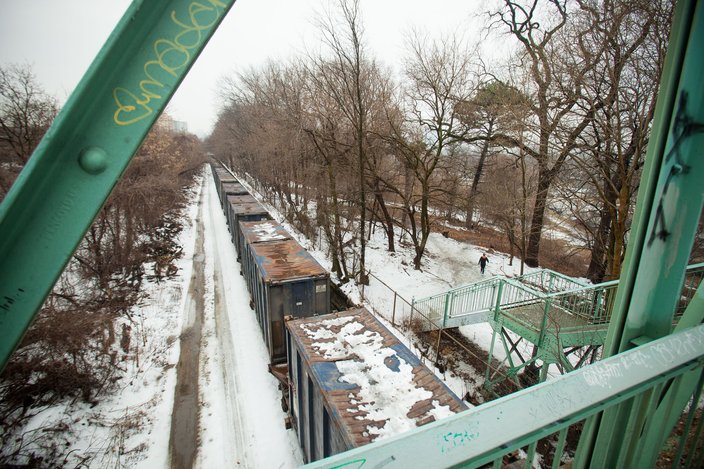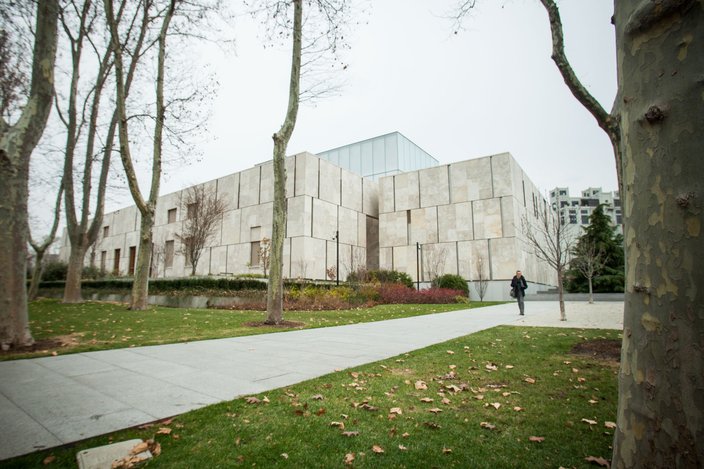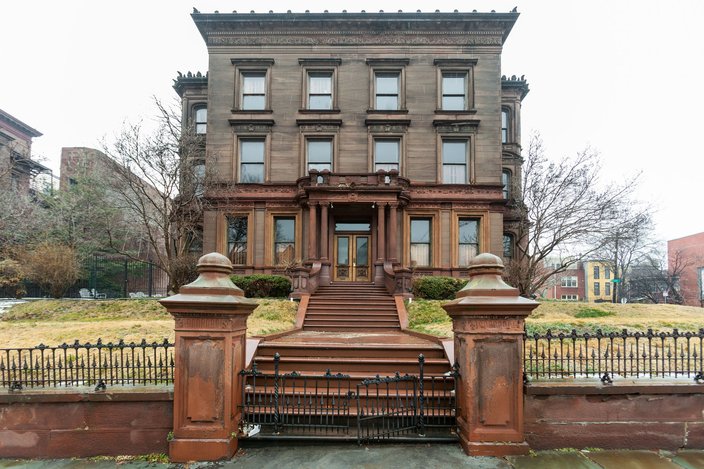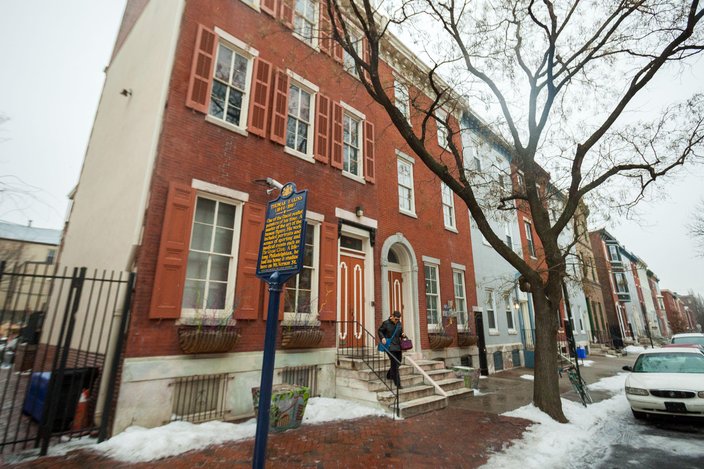
March 06, 2015
 Thom Carroll/PhillyVoice
Thom Carroll/PhillyVoice
The Thinker at the Rodin Museum on the Benjamin Franklin Parkway in Philadelphia.
Every night I go to bed 636 footsteps from “Fifty Days at Illiam,” and every morning I walk past “The Gates of Hell” on my way to get coffee. My neighborhood, where I’ve lived for more than 10 years now, isn’t simply a culmination of pretty words and images from brochures handed out to tourists at the Reading Terminal. It’s a place where Philly’s creative history intersects with its residents, where simply taking a walk down the elegant, tree-lined Benjamin Franklin Parkway, a profoundly symbolic break with William Penn’s otherwise conservative city grid, is like taking a trip through a timeline of the city’s crowning 20th century cultural achievements.
The “Art Museum,” a sophisticated partnership between the Spring Garden and Fairmount neighborhoods, may have become a gimmicky marketing moniker for realtors looking for a sexy way to rebrand the area, but it’s fabled history runs deeper than any duplex or off-street parking could possibly promise. Living here is about being in the presence of a certain grandiosity that has come to define Philly’s museum row, while also finding more human, more small town moments in the shadows of marble and bronze, like chatting with your favorite bartender at the London Grill, or being able to duck into not one, but two phenomenal bookstores (Bookhaven and Book Corner) at a time when shops like these (with their resident cats) are harder and harder to come by.
The Art Museum neighborhood is very much wedged between the past, present (and future) thanks to its old standbys and its new construction (hello, soon-to-be-mega Whole Foods), which is why it’s hard to define it as any one thing. To me, it’s home with some extraordinary perks, including more green space than just about any other neighborhood in Center City. For others, it’s a 15-minute walk from Rittenhouse, a destination with the in-laws on a Sunday, or a memory of a school trip, where the marathon kicks off or even where we watch fireworks on a muggy summer night.
There’s perhaps no better example of this ongoing dichotomy between old and new, personal and public, than the Barnes Foundation itself. Once a dusty collection of art belonging to an eccentric doctor on the Main Line, the sprawling museum has awakened a creative beast. Controversy about how it got here and if it should even be here aside, the building is a stunner on an avenue already lined with stately facades. It’s also where I sometimes take my lunch with a good book, watching as tourists snap serene photos of the reflecting pool as they disembark from oversized buses.
The neighborhood is a monument to what great people have done. It’s easy to be reminded of one’s place in the history of things simply by walking the dog in the evening, past the heroic statue of Joan of Arc during the Battle of Orleans (one of the few public monuments to a woman in the country), past Mark di Suvero’s red mass of beams, “Iroquois,” jutting up from the lawn, past the Charioteer of Delphi from the 5th century, and past the Washington Monument at Eakins Oval.
The old and the new are constantly playing a game of leapfrog here. When it works, you end up with the Bergdoll Mansion, a giant Victorian brownstone that’s been restored to its former glory. Once the home of one of the wealthiest families in the city (they made their money from beer), it fell into disrepair before being brought back to life. When it doesn’t work, you get an endless parade of forgettable restaurants trying to be the next Bishop’s Collar, Bridgid’s or Belgian Cafe. Turns out we are very loyal to our local businesses, many of which have been quietly thriving for years without bells and whistles.
Despite the ongoing ebb and flow of progress in my little enclave, I admittedly spent many years wondering what the difference even was between the Art Museum and Fairmount, often using them interchangeably depending on who I was talking to. That was until I sat at Krupa’s Tavern and got schooled by the locals, people who have made these parts their home for generations. And to hear them tell it, there’s as much an economic split as there is a social one once you cross Fairmount Avenue.
“Fairmounters,” a proud working class people – mostly Irish and Polish – have been hanging their hats in this neighborhood ever since it offered work from one-time bustling lumber and lime yards, iron foundries and breweries. And while Fairmount is no longer the bedroom community to blue collar labor it once was, traces of its insular past are evident, especially in its complicated racial identity as a gateway between Center City and North Philly. The neighborhood is still mostly white, according to the recent census, but gentrification is bumping boundaries every day, pushing into Brewerytown and onto forgotten stretches of Girard Avenue with promises of so-called “luxury” living. But if you walk far enough, poverty is hidden in plain sight, the Chinese food bodegas still have bulletproof glass, and the notion of paying $5 for a soy latte seems absurd.
A somewhat recent addition to Fairmount, OCF Coffeehouse offers a spacious interior with great food, strong coffee and tons of seating. Thom Carroll/PhillyVoice.com
A person could exist on three square meals a day in the neighborhood without ever venturing south of the Parkway. For starters, follow the line to Sabrina’s Café. The diner-style eatery’s become a popular spot for breakfast and bunch (especially on the weekend). If you’re looking for a more low-key snack, both OCF Coffee House and Mugshots Coffeehouse & Café have sweet treats, sandwiches and hot and cold concoctions to get the day started and keep it running with plenty of room for your laptop. Rybread Café is all about sandwiches. The family owned business has earned a reputation for using fresh ingredients (hello, avocado) and taking cues from menus around the country. Stop by Potito’s Italian Bakery for dessert (they have amazing cupcakes).
Dinner is best served at any number of smaller restaurants along Fairmount Avenue, including London Grill where happy hour specials won’t break the bank. Bridgid’s and The Belgian Café are also neighborhood favorites, both with hearty European twists on classic comfort food. In warmer weather, look for outdoor seating where Fido is always welcome. Meanwhile, BYOBs Figs, Trio and Zorba’s Tavern all offer Mediterranean-inspired menus, while Fare keeps it local. For a special occasion, book a reservation at the Waterworks Restaurant and Lounge with stunning views of the river.
Sip with the locals at no-nonsense Krupa’s Tavern, where you can tie one on without spending your paycheck. Similarly, the Green Room is a resident dive bar with pool tables and cheap beer. For date night, take a trip to Jack’s Firehouse where you can sample a huge selection of whiskey and bourbon – just don’t take a spin down the fire pole. Paris Wine Bar, owned by the same folks who operate London Grill, has wine flowing from kegs in an intimate space that feels more like Collette’s living room than anything like it in Philly. Here’s something only a local could know: Beer lovers may want to look up the Parkway Corner Deli on Facebook to find out about beer tastings from breweries like Harpoon, Goose Island and Weyerbacher. Pick up a fancy six-pack while you’re there.
The museum shops at the Barnes Foundation and the Philadelphia Museum of Art both offer
great gift ideas without paying admission, as does The Art Shop at Moore, but the
neighborhood also supports quite a few independent shops, like Ali’s Wagon, for kid’s gear and gifts. Book
lovers can easily spend an afternoon uncovering literary masterpieces at The Book Corner,
a nonprofit owned and operated by the Free Library, and Bookhaven,
a quirky little used bookshop near the Eastern State Penitentiary. If two
wheeling is more your thing, check out Fairmount Bicycles and Philadelphia Bikesmith for
repairs, bikes and rentals. There are also two pet shops in the neighborhood - Fairmount Pet Shoppe and Unleashed
by Petco – where kibble and canine fashions are always in vogue.
Truth is it’s give and take between locals and tourists here, between longtime residents and transplanted young urban professionals with yoga mats tucked under their arms and name-brand dogs lapping up water outside Pizzeria Vetri, and even between the old and young crowding tables at Little Pete’s. These dividing lines, whatever tension they may keep uncomfortably taut as progress steamrolls right on in, do have a precedent, especially if you consider that during the American Revolution, the British set up their defense where the Philadelphia Museum of Art stands today, stretching along what is now Fairmount Avenue all the way across town to the Delaware River. Talk about foreshadowing.
History runs deep here even if it sometimes gets overlooked, like at the Water Works, for example. Did you know it’s one of the earliest examples of Greek Revival Architecture in the country? It’s also one of two landmarks in Philly that Charles Dickens requested to visit in the 1800s (the other was Eastern State, which he hated). There’s also Girard College, which was built by the wealthiest man in America at the time, and the Eakins House, my personal favorite.
As an artist myself, I can’t help but feel a connection with the ghosts of the Art Museum’s past. That Thomas Eakins made his home here, painting some of his most famous works in a humble walk-up on Mt. Vernon Street (it’s now headquarters for the Mural Arts Program), is proof enough that there’s a heightened awareness of creative invention in this pocket of the city. And while Eakins may have been dismissed from the Pennsylvania Academy of Fine Arts for suspect behavior back in the day, his presence can still be felt on these streets, along the river where he sketched rowers, and where he retired after spending the day with Walt Whitman in Camden.
From my own voyeuristic perch at the Parkway House, one of the first postwar luxury residences designed by a female architect, I create my own interpretations of the neighborhood, influenced by light and architecture, not to mention a few Rear Window moments that would make even Hitchcock blush. Interestingly, this building also hosted its share of luminaries over the years, including an aging Marc Chagall who visited the Mann family (they founded the Mann Music Center). I like to imagine that Chagall stood looking out onto the same park as I do now, where each spring is anointed with the first clacks of baseball bats and the green is really green come June.
I’ve spent my thirties here documenting the seasons coming and going, capturing the many moods of the city on Facebook and Instagram. I’ve watched the skyline change, the Comcast and Cira Center go up in snow, rain and sunshine, ignited by the some of the most sensational sunsets you will ever see gleaming off of our Emerald City. I’ve also learned how to see things in a new way simply by living here, a place that can challenge what we think we know about the time in which we walk the streets and the history we slink past on the way to get a loaf of bread. It’s a valuable ego check for any writer or artist at any age.
If anything, my neighborhood has also taught me to be generous, especially when tourists and day-trippers crowd the sidewalks, stopping to take selfies with The Thinker and making a run for it like Rocky up the Art Museum stairs. And on the 4th of July, it becomes America’s backyard. As residents, we may feel a selfish ownership over our neighborhood. It may not always be easy feigning patience when someone stops to ask you for directions for the hundredth time, when 22nd Street is bumper to bumper at rush hour, when you can’t ever find a parking space, or when Jay Z comes to town, but it’s all worth it when you realize that you get to live amidst all of this – the summer celebrations, the winter solitude, one of the most respected art collections in the world and the proverbial right brain of the city.
Natalie Hope McDonald is a writer and artist. Follow her on Twitter at @nataliemcd.







